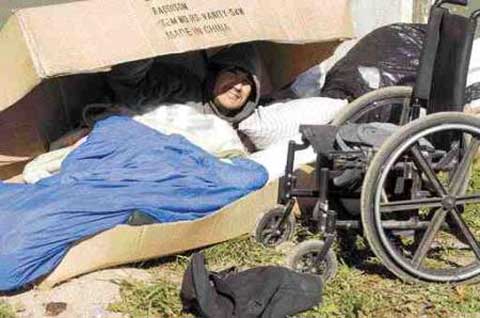
 |
Ken Budd, who has been homeless for two months, keeps his wheelchair within arm's reach while sleeping on the riverbank Photograph by : SP Photo by Richard Marjan |
Gold leaves fluttered by on the ground and the warm sunlight sparkled on the South Saskatchewan River as Budd, 25, pushed back the top of the box and squinted out at the day, checking to see his wheelchair was still parked within arm's reach, where he'd left it the night before.
"It was cold last night but I have lots of blankets," he said, as he held a sleeping bag and a thick pile blanket around himself.
The thought of the roast turkey and stuffing, potatoes and gravy, veggies and fruit pie being served up at the Friendship Inn reminded Budd that he hadn't eaten the day before and he was soon hauling himself out of the box and into the wheelchair.
As he leaned into the wheels and forced the lightweight chair up the steep roadway from the boat launch beside the Broadway Bridge, Budd explained he's been living on the street for the past two months. He doesn't have an address right now and isn't receiving welfare support, he said.
Instead, he panhandles downtown most days to collect enough change for a meal.
He was born with spina bifida and has used a wheelchair all his life. His parents are dead and he grew up in a series of foster homes. He's been on his own, sometimes living in social housing arrangements, since he was 17.
Budd says he and a friend, Wally, recently tried to find a place where they could share the rent, but after two weeks of phoning around they failed to secure shelter for the coming winter.
In the past year, Budd has stayed with friends, sometimes sleeping in a bathtub, and has lived on the street. Last winter, he says he spent more than a few nights sleeping on the floors of banks beneath automated teller machines.
Budd's practiced arms manoeuvre the little chair quickly westward on 20th Street. He makes a brief detour to use a public washroom and continues on his way. It's not yet 12:15 p.m. and the meal will be served until 1:30 p.m., giving Budd time to swing by 21st Street in hope of collecting some change. Unfortunately for him, the lovely fall day has drawn out many other panhandlers and he decides there's too much competition to hang around.
He's in a good mood nonetheless and he chuckles as another guy in a wheelchair, who has been asking strangers for change, rolls by holding four golf clubs in his lap.
"I don't know what he's doing with those," Budd says, his eyes crinkling as he smiles and shakes his head.
Half an hour later, Budd is wheeling into the familiar red brick building between avenues F and G on 20th Street. Minutes later, he's at the end of a table, chatting with friends and enjoying the Thanksgiving meal. He's right at home and many people know him by name.
About 1,000 people were served Thanksgiving dinner on Sunday, according to Friendship Inn executive director Geselle Doell, many of those among Saskatoon's homeless population.
A recent survey by University of Saskatchewan nursing students suggests 25 per cent of Friendship Inn clients are homeless and 12 per cent are "hidden homeless," meaning they stay with friends or relatives, moving often and never having their own home.
The students were asked to conduct the survey by a committee of community groups which meets to address the housing crisis, Doell said.
"What is happening in our city with the economy going so fast? Are there more homeless due to the rent increases?" Doell asked.
"A lot of apartments are going condo. It does make a huge difference."
Coun. Pat Lorje was among the volunteers serving the meal and is on the committee. She understands there are about 200 homeless people living on the streets in Saskatoon.
"It's kind of a hidden issue. You're not aware until you see somebody living in a box with a wheelchair beside it," she said.
The committee is working on a plan to create emergency shelters in church basements for the coming winter, she said.
The committee involves about 30 church groups, the health region and other agencies and government departments, she said.
City council is also responding to the problem by doubling its contribution to affordable housing projects undertaken by organizations such as Habitat For Humanity, aboriginal groups and church groups, Lorje said. The city provides up to 10 per cent of the cost, she said.
© The StarPhoenix (Saskatoon) 2007